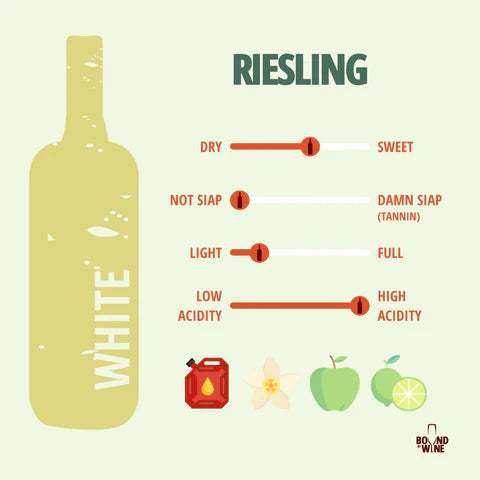
Riesling is commonly known as a sweet aromatic while, but it is actually modernly produced in a variety of styles from bone-dry to very sweet. It has emerged as one of the most collectible white wines in the world, with Germany being the world’s most important producer of Riesling.
TASTE PROFILE

It sometimes has that distinct petroleum like texture & aroma, but it's not a bad thing, as it integrates well with it's lime applie, beeswax notes. Expect aromas like apricots, honey apples & lime peel, as well as floral notes of honeycomb and jasmine.
It was originally created as a sweet style to balance out it's high acidity, but there's a growing amount of dry style Rieslings as well, which have a much leaner profile. Off-dry Riesling wines make a great pairing to spicy Indian and Asian cuisines and do excellently alongside duck, pork, bacon, shrimp and crab.
What's unique with riesling is that it has the potential to age & develop more personality, due to it's high acidity & minerality. It's ageing potential is exaggerated in it's sweeter styles
WINEMAKING REGIONS
Classic representations of Riesling mostly come from Mosel, with a distinct flavor of slate rocks from where Mosel Riesling grows. To identify dry style Rieslings, look out for Rieslings from Alsace, or "Trocken" labelled German Riesling. Australian Riesling from Clare & Eden Valleys are usually dry as well.
Most quality Riesling regions produce rieslings with the ability to ago for 20 years at least.
MOSEL, GERMANY
Distinctly recognised by the winding Mosel River, Mosel (together with Alsace in France) is known as the birthplace of Riesling. It's wines are split in a simple 3 tier classification system, from Qualitatswein (QbA), to Pradikatswein & VDP (Verband Deutscher Prädikatsweingüter)
Pradikatswein is the most common designation, with is further divided by the style of the wine & harvest, and is used internationally for riesling
- Kabinett is the off dry style, and is the most common
- Spatlese is a late harvest style. Dry Spatlese are often labeled as "Trocken".
- Auslese are selected harvests with some level of noble rot, which adds notes of beeswax & ginger.
- Beerenauslese has higher noble rot, creating very sweet wines
- Trockenbeerenauslese has the highest noble rot, made to use highest end sweet wines
- Eiswein only happens when grapes freeze and are harvested frozen.
On top of this, look for different sub-regional styles. There are 6 different sub-regions but Saar, Ruwertal & Bernkastel recieve the most attention.
ALSACE, FRANCE
A sunny dry region located on France's border with Germany, most rieslings from Alsace are dry with ageing potential. Expect ripeness from the sunny climate, but also taut acidity & intense minerality. A great pick for something bright & refreshing, but still with complexity & texture.
AUSTRIA
Known for great structure & crispness, Austrian Riesling is usually dry & less acidic than those from Germany. Hot sunny days & cool nights allow fruit to fully ripen, allowing winemakers to fully ferment the wine & create dry Riesligs.
They are mainly produced in 3 regions; Wachau, Kremstal & Kamptal, all with a distinct flinty character.
CLARE & EDEN VALLEY, AUSTRALIA
There is a distinctive style from Australian Riesling, with racy acidity and bright fruit notes in mostly bone dry and the occassional off dry style. Clare Valley's huge day-night temperature difference allows Riesling to florish, offering notes of lime, lavender & stony minerals. Eden Valley on the hand have a talc-like texture, and provide something more complex.
OTHER REGIONS
Other regions that have picked up Riesling would be the USA & New Zealand




















































